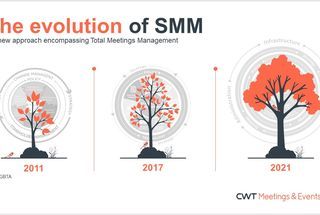The Evolution of Strategic Meetings Management to Total Meetings Management

The pandemic has made organizations recognize the importance of effective risk management in meetings and events. As lockdowns and travel restrictions were imposed last year, organizations scrambled to figure out what meetings their employees had booked, who was organizing them, and the financial impact of cancellations. While we continue to navigate the current crisis, now is a good time for organizations to start preparing their M&E programs for present and future risks.
Strategic Meetings Management (SMM), a disciplined approach to managing meetings and events across an organization, is considered a highly effective way to manage risks associated with meetings and events. The Global Business Travel Association's (GBTA) Meetings & Events Committee developed the first SMM ‘wheel’ back in 2003, identifying for the first time the necessary components for a robust SMM program. Over the years, the wheel has been through several iterations, adapting to the changing landscape, with the most recent version being released in 2017. I believe now is the right time for SMM to take the next step in its evolutionary journey.
In my previous blog, I talked about some of the challenges organizations encounter despite using the wheel as the foundation for their SMM programs. That's why it's important to include the guiding principles of Infrastructure, Governance, and Administration to create SMM programs that deliver on the intended results.
At the same time, we often see certain meeting types such as small, virtual, hybrid, executive, sponsorship, congresses, events, and healthcare professional (HCP) meetings in the life sciences sector are left out of SMM programs. SMM must evolve to include the totality of ALL meetings and events activity. At CWT Meetings & Events, we refer to this evolution as Total Meetings Management (TMM).
This is based on the reality that all meeting types derive benefit from inclusion in such strategies. The objectives of governance and visibility are only achieved with a holistic approach. TMM is not replacing SMM but becomes embedded within your strategy and can be easily incorporated as part of a phased approach.
The key is to focus on totality to break down silos. The business unit, ability to generate leads, size, attendee type, or even how/by whom meetings are planned is important. Still, it should not outweigh the objectives of the overall strategy or lead to excluding those meetings from your program. TMM is
inclusive of maximizing the value the SMM delivers. One of many actions to take when incorporating TMM is simply registering all meetings. This gives your SMM the ability to collect auditable data, support demand management strategies, and provide reporting that drives business decisions. That way, in your everyday business operations or when another adverse event or crisis happens, there is complete visibility into your program, allowing you to be proactive rather than reactive in your response. That is just one of many reasons why TMM is the next practice approach to the ever-evolving SMM methodology.
Want to learn more about this unique approach? Contact our SMM Consulting Solutions Team for more information.
About CWT
CWT is a Business-to-Business-for-Employees (B2B4E) travel management platform. Companies and governments rely on us to keep their people connected – anywhere, anytime, anyhow – and, across six continents, we provide their employees with innovative technology and an efficient, safe, and secure travel experience.
Engage with us via LinkedIn, Facebook, Twitter and our Podcast.